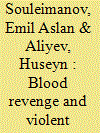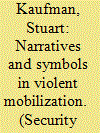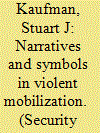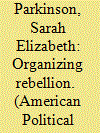|
|
|
Sort Order |
|
|
|
Items / Page
|
|
|
|
|
|
|
| Srl | Item |
| 1 |
ID:
142115


|
|
|
|
|
| Summary/Abstract |
Despite a considerable amount of ethnographic research into the phenomena of blood revenge and blood feud, little is known about the role of blood revenge in political violence, armed conflict, and irregular war. Yet blood revenge—widespread among many conflict-affected societies of the Middle East, North Africa, and beyond—is not confined to the realm of communal infighting, as previous research has presumed. An empirical analysis of Russia's two counterinsurgency campaigns in Chechnya suggests that the practice of blood revenge has functioned as an important mechanism in encouraging violent mobilization in the local population against the Russian troops and their Chechen proxies. The need to exact blood revenge has taken precedence over an individual's political views, or lack thereof. Triggered by the loss of a relative or humiliation, many apolitical Chechens who initially sought to avoid involvement in the hostilities or who had been skeptical of the insurgency mobilized to exact blood revenge to restore their individual and clan honor. Blood revenge functions as an effective, yet heavily underexplored, grievance-based mechanism encouraging violent mobilization in irregular wars.
|
|
|
|
|
|
|
|
|
|
|
|
|
|
|
|
| 2 |
ID:
091374


|
|
|
| 3 |
ID:
091788


|
|
|
|
|
| Publication |
2009.
|
| Summary/Abstract |
According to symbolic politics theory, group fears and narratives of group identity that justify hostility are key causes of violent ethno-national conflict. In the Palestinian-Israeli conflict, widely accepted narratives on each side define group identity and group relations in ways that generate incompatible demands on Jerusalem, territory, refugees, security, and other issues. Historical memories of the Holocaust, the Nakba, and other tragedies generate fears of extinction on both sides, and stereotypes encourage beliefs on each side that the other responds only to force. These narratives enable hard-line leaders on both sides to manipulate emotive symbols to block compromise and escalate conflict. Thus the cause of both the failure of Palestinian-Israeli negotiations in 2000-01 and the simultaneous outbreak of the latest Palestinian-Israeli war lies in the irreconcilable demands that are rooted in each side's competing narratives of national identity.
|
|
|
|
|
|
|
|
|
|
|
|
|
|
|
|
| 4 |
ID:
127788


|
|
|
|
|
| Publication |
2014.
|
| Summary/Abstract |
Research on violent mobilization broadly emphasizes who joins rebellions and why, but neglects to explain the timing or nature of participation. Support and logistical apparatuses play critical roles in sustaining armed conflict, but scholars have not explained role differentiation within militant organizations or accounted for the structures, processes, and practices that produce discrete categories of fighters, soldiers, and staff. Extant theories consequently conflate mobilization and participation in rebel organizations with frontline combat. This article argues that, to understand wartime mobilization and organizational resilience, scholars must situate militants in their organizational and social context. By tracing the emergence and evolution of female-dominated clandestine supply, financial, and information networks in 1980s Lebanon, it demonstrates that mobilization pathways and organizational subdivisions emerge from the systematic overlap between formal militant hierarchies and quotidian social networks. In doing so, this article elucidates the nuanced relationship between social structure, militant organizations, and sustained rebellion.
|
|
|
|
|
|
|
|
|
|
|
|
|
|
|
|
|
|
|
|
|